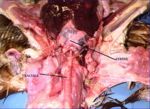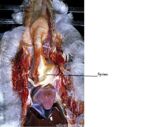Difference between revisions of "Syrinx - Anatomy & Physiology"
Jump to navigation
Jump to search
m (Text replace - "Oral Cavity - Tongue - Anatomy & Physiology" to "Tongue - Anatomy & Physiology") |
|||
| Line 54: | Line 54: | ||
*Sexual dimorphisms occurs in songbirds, with the males of the species usually producing a more complex birdsong, which directly relates to the size of the area of the brain responsible for song | *Sexual dimorphisms occurs in songbirds, with the males of the species usually producing a more complex birdsong, which directly relates to the size of the area of the brain responsible for song | ||
| − | *Parrots have a thick [[ | + | *Parrots have a thick [[Tongue - Anatomy & Physiology|tongue]] which allows them to make sounds similar to humans |
| − | *Sound travels from the syrinx and is modified in the throat, [[ | + | *Sound travels from the syrinx and is modified in the throat, [[Tongue - Anatomy & Physiology|tongue]] and mouth in parrots |
==Test yourself with the Syrinx Flashcards== | ==Test yourself with the Syrinx Flashcards== | ||
Revision as of 17:08, 4 September 2010
|
|
Introduction
Vocalisation is an important evolutionary ability of birds. The extent of song varies in different avian species from complex pitches, patterns and rhythms in songbirds to the amusing squawk of penguins. Birds lack vocal folds so sound is produced in the syrinx which is the avian equivalent of the mammalian vocal cords.
Structure
- Specialisation of the trachea bifurcation
- Located at the caudal end of the trachea and at the beginning of the primary bronchi
- Tracheal cartilages of the syrinx are complete and sturdy
- Bronchial cartilages are incomplete
- Paired sternotrachealis muscle pulls the trachea towards the syrinx
- Shape and size of syrinx varies between species
- Composed of ossified cartilages, vibrating membranes and muscles
- Surrounded by an air sac
Function
- Lateral and medial walls of the primary bronchi are membranous and flutter which produces sound
- Sound is produced on expiration
- Increased pressure in the clavicular air sac causes the tympanic membrane of the syrinx to be forced into the lumen and vibrate
- Tension of the membranes is controlled by the tracheolateral muscles
- Each half of the syrinx can function independently allowing 2 different notes to be produced at the same time
Species Differences
- Drakes and Cobs (male swans) have an enlarged osseous bulla on the left side of the syrinx which acts as a resonator
- Songbirds have a complex set of syringeal muscles
- Sexual dimorphisms occurs in songbirds, with the males of the species usually producing a more complex birdsong, which directly relates to the size of the area of the brain responsible for song
- Parrots have a thick tongue which allows them to make sounds similar to humans
- Sound travels from the syrinx and is modified in the throat, tongue and mouth in parrots

